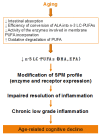n-3 Polyunsaturated Fatty Acids and Their Derivates Reduce Neuroinflammation during Aging
- PMID: 32121189
- PMCID: PMC7146513
- DOI: 10.3390/nu12030647
n-3 Polyunsaturated Fatty Acids and Their Derivates Reduce Neuroinflammation during Aging
Abstract
: Aging is associated to cognitive decline, which can lead to loss of life quality, personal suffering, and ultimately neurodegenerative diseases. Neuroinflammation is one of the mechanisms explaining the loss of cognitive functions. Indeed, aging is associated to the activation of inflammatory signaling pathways, which can be targeted by specific nutrients with anti-inflammatory effects. Dietary n-3 polyunsaturated fatty acids (PUFAs) are particularly attractive as they are present in the brain, possess immunomodulatory properties, and are precursors of lipid derivates named specialized pro-resolving mediators (SPM). SPMs are crucially involved in the resolution of inflammation that is modified during aging, resulting in chronic inflammation. In this review, we first examine the effect of aging on neuroinflammation and then evaluate the potential beneficial effect of n-3 PUFA as precursors of bioactive derivates, particularly during aging, on the resolution of inflammation. Lastly, we highlight evidence supporting a role of n-3 PUFA during aging.
Keywords: Key-words: aging; cognitive decline; n-3 polyunsaturated fatty acids; neuroinflammation; resolution of inflammation; specialized pro-resolving mediators.
Conflict of interest statement
The authors declare no conflict of interest.
Figures


Similar articles
-
N-3 Polyunsaturated Fatty Acids and the Resolution of Neuroinflammation.Front Pharmacol. 2019 Sep 13;10:1022. doi: 10.3389/fphar.2019.01022. eCollection 2019. Front Pharmacol. 2019. PMID: 31607902 Free PMC article. Review.
-
Dietary n-3 long chain PUFA supplementation promotes a pro-resolving oxylipin profile in the brain.Brain Behav Immun. 2019 Feb;76:17-27. doi: 10.1016/j.bbi.2018.07.025. Epub 2018 Aug 4. Brain Behav Immun. 2019. PMID: 30086401
-
Role of Specialized Pro-resolving Mediators in Reducing Neuroinflammation in Neurodegenerative Disorders.Front Aging Neurosci. 2022 Feb 17;14:780811. doi: 10.3389/fnagi.2022.780811. eCollection 2022. Front Aging Neurosci. 2022. PMID: 35250536 Free PMC article. Review.
-
N-3 polyunsaturated fatty acids in animal models with neuroinflammation: An update.Eur J Pharmacol. 2016 Aug 15;785:187-206. doi: 10.1016/j.ejphar.2015.05.045. Epub 2015 May 30. Eur J Pharmacol. 2016. PMID: 26036964 Review.
-
Effects of maternal n-3 fatty acid supplementation on placental cytokines, pro-resolving lipid mediators and their precursors.Reproduction. 2015 Feb;149(2):171-8. doi: 10.1530/REP-14-0549. Epub 2014 Dec 12. Reproduction. 2015. PMID: 25504868 Clinical Trial.
Cited by
-
Protective Role of Eicosapentaenoic and Docosahexaenoic and Their N-Ethanolamide Derivatives in Olfactory Glial Cells Affected by Lipopolysaccharide-Induced Neuroinflammation.Molecules. 2024 Oct 11;29(20):4821. doi: 10.3390/molecules29204821. Molecules. 2024. PMID: 39459191 Free PMC article.
-
Impact of multidomain preventive strategies on functional brain connectivity in older adults with cognitive complaint: Subset from the Montpellier center of the ancillary MAPT-MRI study.Front Aging Neurosci. 2023 Jan 10;14:971220. doi: 10.3389/fnagi.2022.971220. eCollection 2022. Front Aging Neurosci. 2023. PMID: 36705622 Free PMC article.
-
Fatty Acids: An Insight into the Pathogenesis of Neurodegenerative Diseases and Therapeutic Potential.Int J Mol Sci. 2022 Feb 25;23(5):2577. doi: 10.3390/ijms23052577. Int J Mol Sci. 2022. PMID: 35269720 Free PMC article. Review.
-
Immunity and Nutrition: The Right Balance in Inflammatory Bowel Disease.Cells. 2022 Jan 28;11(3):455. doi: 10.3390/cells11030455. Cells. 2022. PMID: 35159265 Free PMC article. Review.
-
N-3 PUFA Prevent Oxidative Stress in a Rat Model of Beta-Amyloid-Induced Toxicity.Pharmaceuticals (Basel). 2021 Apr 8;14(4):339. doi: 10.3390/ph14040339. Pharmaceuticals (Basel). 2021. PMID: 33917814 Free PMC article.
References
-
- Bousquet J., Kuh D., Bewick M., Standberg T., Farrell J., Pengelly R., Joel M.E., Rodriguez Mañas L., Mercier J., Bringer J., et al. Operational Definition of Active and Healthy Ageing (AHA): A Conceptual Framework. J. Nutr. Health Aging. 2015;19:955–960. doi: 10.1007/s12603-015-0589-6. - DOI - PubMed
Publication types
MeSH terms
Substances
LinkOut - more resources
Full Text Sources
Medical

